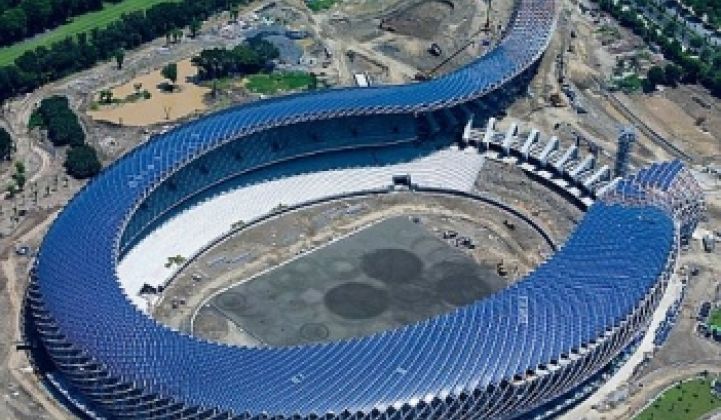TAIPEI, Taiwan -- The recent passage of a feed-in tariff policy in Taiwan could be a nice boost for the country's solar companies, even if the industry is aiming to win over markets much larger than the domestic one.
The Parliament greenlighted the Renewable Energy Development Act and sought to replicate the success experienced by some of the European countries in promoting renewable energy use as well as solar technology development and sales.
A feed-in tariff policy requires utilities to buy all the solar power available for sale at premium, government-set prices via long-turn contracts. Home or business owners could participate by installing solar energy systems on their rooftops. Such policy also has enticed developers to build large solar power installations and sell them to investors.
Taiwan's solar market would be small compared with the ones targeted by Taiwanese solar companies, such as Germany, Italy, China and the United States. But serving what could become a booming domestic market wouldn't hurt.
"The industry will grow very fast because of the renewable energy act," said Frank O'Young, CEO of Sunner Solar, which makes amorphous silicon solar panels.
The new legislation also provides a psychological boost for companies that have experienced the same financial crunch and sluggish market demand that have plagued their competitors in Japan, the United States and Europe.
The country has nearly four dozen manufacturers of silicon ingots and wafers, solar cells and panels, as well as 31 installers, some of which also make the equipment, according to the government-funded Industrial Technology Research Institute (ITRI).
Taiwan is one of the top producing countries of solar cells and panels worldwide. Motech Industries ranked No. 6 in photovoltaic equipment production in 2008, according to Navigant Consulting.
The country has more solar cell producers than panel or ingot/wafer makers. The solar cell makers shipped about 900 megawatts in 2008, up from 433 megawatts in 2007, ITRI said. Their customers are mainly located in Europe and China.
The interest in solar cell production came from Taiwan's long history in semiconductor manufacturing, which shares similar production processes, said Quincy Lin, chairman of Neo Solar Power. Lin was the senior vice president of Taiwan Semiconductor Manufacturing Co., the world's largest contract chip maker who recently announced it's going to get into the solar business (see Green Light post).
But these relatively young companies aren't likely to open factories in China, where many Taiwan-based semiconductor and consumer electronics makers have opened factories in the past decade. Company executives said they want to build up manufacturing muscle in Taiwan first before considering moving abroad.
"You don't want to build many small factories. You want to build one large one," said Andy Shen, senior vice president of worldwide sales and marketing at Neo Solar. Founded in 2005, Neo Solar posted about $318 million in revenue in 2008, up from $114 million in 2007.
Many of these solar companies have set up shop in science parks the government created up and down Taiwan. Some are located on large vacant lots outside of towns, with plans to increase their production by hundreds of megawatts on the same location. A high-speed railway that began operating in 2007 has significantly shortened the travel time among these high-tech clusters from Taipei in the north to Tainan in the south.
Taiwan's government, meanwhile, wants to nurture a domestic appetite for some of these companies' products.
The passage of the feed-in tariff policy was a step in that direction. But the government has yet to decide on some key elements, such as the pricing for solar electricity. The policy would apply not only to solar but other forms of renewable power.
The solar companies are lobbying for NT$8 per kilowatt hour, which would be substantially higher than what the government-owned Taiwan Power Co. is willing to pay currently: NT$2 per kilowatt hour.
The government is expected to launch the feed-in tariff program in six months, said Joeng-Shein Chen, a senior solar researcher at ITRI, which advises the government on technology issues.
There would be no annual cap on the amount of solar power that could be installed under the program, Chen said. That'd be a wise move. Analysts have criticized Spain for setting such a cap and causing a dramatic boom-bust cycle (see Spain: The Solar Frontier No More and U.S. Solar Market: So Promising, Except for 2009).
Taiwan's lawmakers did set a goal of installing up to 10 gigawatts of various types of renewable power in 20 years.
Taiwan installed about 3.5 megawatts of solar energy systems, up from 2 megawatts in 2007, ITRI said. It already installed 2.5 additional megawatts for the first six months of this year.
Even before lawmakers approved the renewable energy act, ITRI was forecasting that the amount of installed solar power could jump from 1.6 megawatts in 2006 to 31 megawatts in 2010.
The largest installation on the island is a 1-megawatt system that hugs the perimeter of a sports stadium like a dragon in the southern port city of Kaohsiung (the installation is pictured above).
Image via hiroshiken.
Join experts and influencers at Greentech Media's Growth Opportunities in the New PV Market: Projects, Finance and Policy in San Francisco on July 13.




